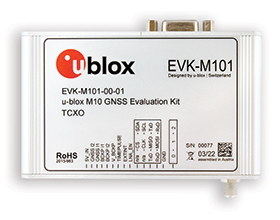Measure GNSS power consumption without a digital meter
31 May 2023
Telecoms, Datacoms, Wireless, IoT

Engineers developing IoT products, or wearables with embedded positioning modules, work hard to improve the design of devices. Besides bringing more accuracy to the table, size, form, adaptability, and battery consumption are aspects that are considered. Power consumption of a GNSS module is closely related to enhancing positioning accuracy; basically, more accuracy usually translates into more power consumption.
Each device consumes energy at different rates depending on capabilities and characteristics. Firmware engineers use various strategies to optimise power consumption. They change firmware settings to make the most out of the device and reduce it to a minimum.
Using a digital meter to measure power consumption, however, is time-consuming. For starters, engineers need access to such a device, find the correct cable adaptors, and connect it correctly. Secondly, they can measure only a single voltage value over a shunt resistor at a time. Finally, they must convert the measured voltage into a current consumption value.
However, as technology evolves, an evaluation kit is currently the easiest way to analyse key performance indicators, including power consumption.
The EVK-M101 is the evaluation kit of u-blox M10. It can measure the current consumption of the M10 chip and connected components like the oscillator, flash memory, and low-noise amplifier. In real time, the GNSS evaluation software u-center 2 can also display the current consumption through the chip and connected components from the EVK-M101. The platform calculates the power automatically as it measures voltages simultaneously – all of this without the support of a digital meter.
Further reading:
What does Wi-Fi 7 mean for South African networks?
Telecoms, Datacoms, Wireless, IoT
With Wi-Fi 7 (802.11be), we are finally looking at a standard that was built, not just for more devices, but for the new way networks are used.
Read more...
Multiprotocol wireless SoC
RF Design
Telecoms, Datacoms, Wireless, IoT
The nRF54LM20A from Nordic Semiconductor is a multiprotocol wireless System-on-Chip designed for demanding designs in Bluetooth devices.
Read more...
High performance communication
iCorp Technologies
Telecoms, Datacoms, Wireless, IoT
Quectel’s FCS950R is a high-performance Wi-Fi 5 and Bluetooth 4.2 module that can deliver a maximum data rate up to 433,3 Mbps in 802.11ac mode.
Read more...
Expanded STM32WL3x line for IoT sensors
Altron Arrow
Telecoms, Datacoms, Wireless, IoT
The STM32WL31x and STM32WL30x are more tailored versions of the STM32WL33x for designers who wish to focus on specific features, while lowering their bill of materials.
Read more...
Full-band GNSS helical antenna
RF Design
Telecoms, Datacoms, Wireless, IoT
A key feature of Calian’s HC3990XF antenna design is that it does not require a ground plane, making it ideal for size-constrained applications.
Read more...
BLE and BT Mesh module
iCorp Technologies
Telecoms, Datacoms, Wireless, IoT
The HM-BT4531 from HOPERF is a BLE data transmission module that features an ARM Cortex-M0 32-bit processor.
Read more...
Espressif entering the Wi-Fi 6E market
iCorp Technologies
Telecoms, Datacoms, Wireless, IoT
Espressif Systems is entering the Wi-Fi 6E market, extending its connectivity portfolio into the domain of high-throughput, low-latency wireless solutions.
Read more...
Ultra-low jitter clock buffers
Altron Arrow
Telecoms, Datacoms, Wireless, IoT
New SKY53510/80/40 family of clock fanout buffers from Skyworks are purpose-built for data centres, wireless networks, and PCIe Gen 7 applications.
Read more...
Cutting-edge broadband power amplifier
RFiber Solutions
Telecoms, Datacoms, Wireless, IoT
Designed for high efficiency and reliability, the WPGM0206012M from WAVEPIA is a cutting-edge broadband GaN MMIC power amplifier operating from 500 MHz to 8,5 GHz.
Read more...
The trends driving uptake of IoT Platform as a Service
Trinity IoT
Editor's Choice Telecoms, Datacoms, Wireless, IoT
IoT platforms, delivered as a service, are the key that will enable enterprises to leverage a number of growing trends within the IT space, and access a range of benefits that will help them grow their businesses.
Read more...


